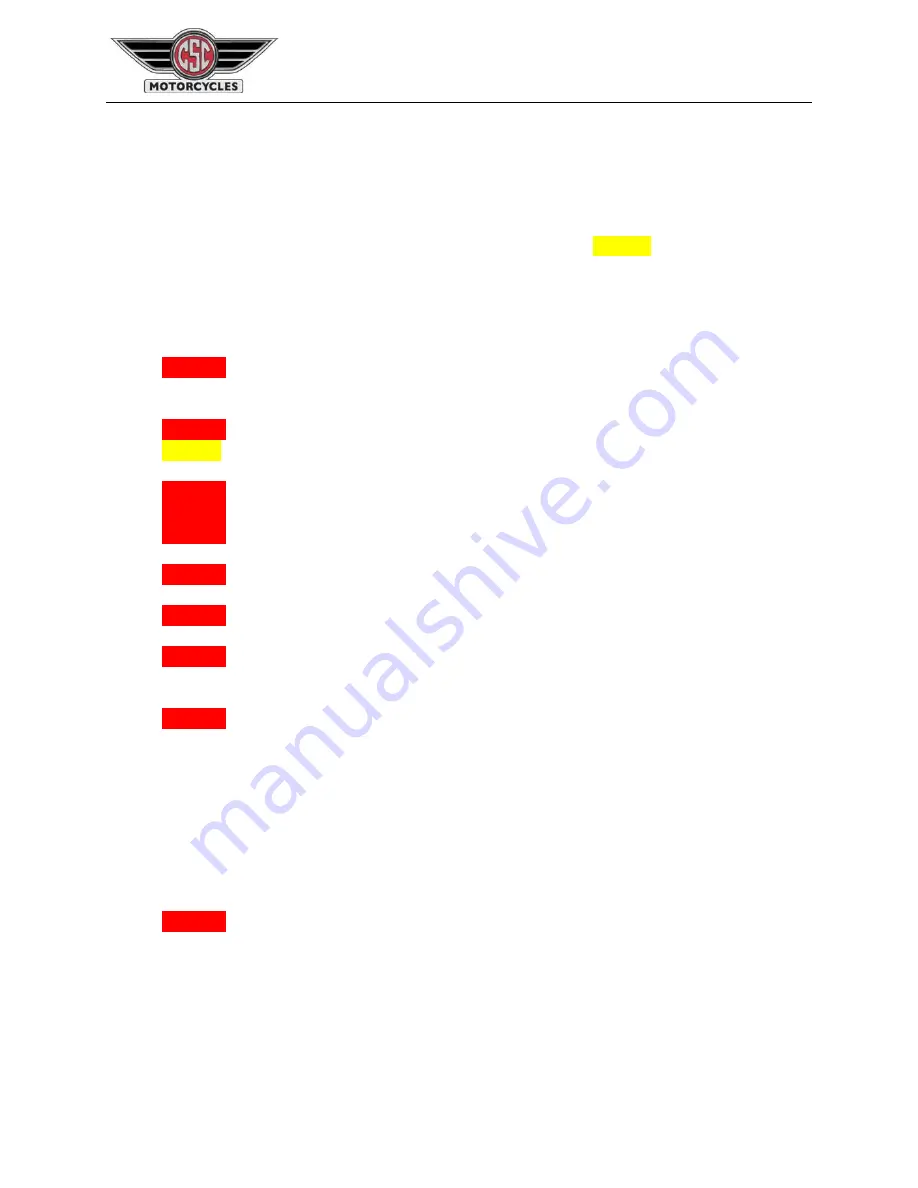
TT250
Owner’s
and
Service
Manual
www.CSCMotorcycles.com
16
Section
2:
Service
Manual
Maintenance
Cautions
and
Warnings
When
you
repair
the
motorcycle,
please
use
original
components
and
parts,
accessories,
lubricating
oil
and
other
materials
that
are
made
or
recognized
by
CSC
Motorcycles.
Caution!
If
you
use
any
parts
or
components
other
than
those
recommended
by
CSC,
it
may
adversely
affect
the
performance,
reliability,
stability,
or
warranty
of
your
motorcycle.
When
working
on
your
motorcycle,
you
should
follow
this
guidance:
Warning!
Whenever
the
motorcycle
is
to
be
reassembled
after
disassembly,
washers,
seals,
and
cotter
pins
need
to
be
replaced.
When
you
fasten
a
series
of
bolts
or
nuts,
you
should
do
so
in
a
diagonal
pattern.
Warning!
Do
not
use
flammable
cleaning
fluid
to
clean
components
and
parts.
Caution!
Before
assembly
operations,
add
lubricating
oil
or
lubricating
grease
to
lubricated
surfaces.
Warning!
After
assembly,
make
sure
all
parts
are
properly
assembled
and
tightened.
Warning!
Stop
the
engine
when
repairing
the
motorcycle.
Warning!
If
the
maintenance
operation
needs
to
be
done
while
the
engine
is
working,
make
sure
the
area
is
well
‐
ventilated.
Warning!
Gas
is
flammable
and
combustible,
so
do
not
smoke
or
provide
ignition
sources
in
the
work
area.
Warning!
The
battery
can
liberate
hydrogen,
which
is
flammable.
Do
not
smoke,
ignite
or
make
sparks
near
the
battery,
especially
when
it
is
charging.
Warning!
The
electrolyte
of
the
battery
contains
sulfuric
acid.
If
your
eyes,
skin
or
clothes
are
splashed
with
electrolyte,
rinse
them
thoroughly
with
water
and
seek
immediate
medical
attention.
Warning!
Disconnect
the
negative
battery
terminal
when
performing
any
maintenance
on
the
motorcycle
engine,
drive
train,
or
fuel
system.
Component
Cleaning
After
parts
are
disassembled,
they
may
need
to
be
cleaned.
Cleaning
methods
vary
according
to
the
characteristics
of
the
parts.
To
remove
oil
or
grease
contamination,
CSC
recommends
using
Simple
Green
or
other
similar
degreasing
agents.
Warning!
Never
use
gasoline
as
a
cleaning
agent.
To
remove
carbon
deposits,
use
mechanical
or
chemical
methods.
The
mechanical
method
uses
a
wooden
or
plastic
scraper
or
blade
to
clear
the
carbon
deposit
first,
and
then
rinse
the
parts
with
an
appropriate
cleaning
agent.
The
chemical
method
is
to
soak
the
parts
in
the
cleaning
agent
first,
then
clean
them
with
a
brush,
and
then
rinse
them
with
hot
water.
















































